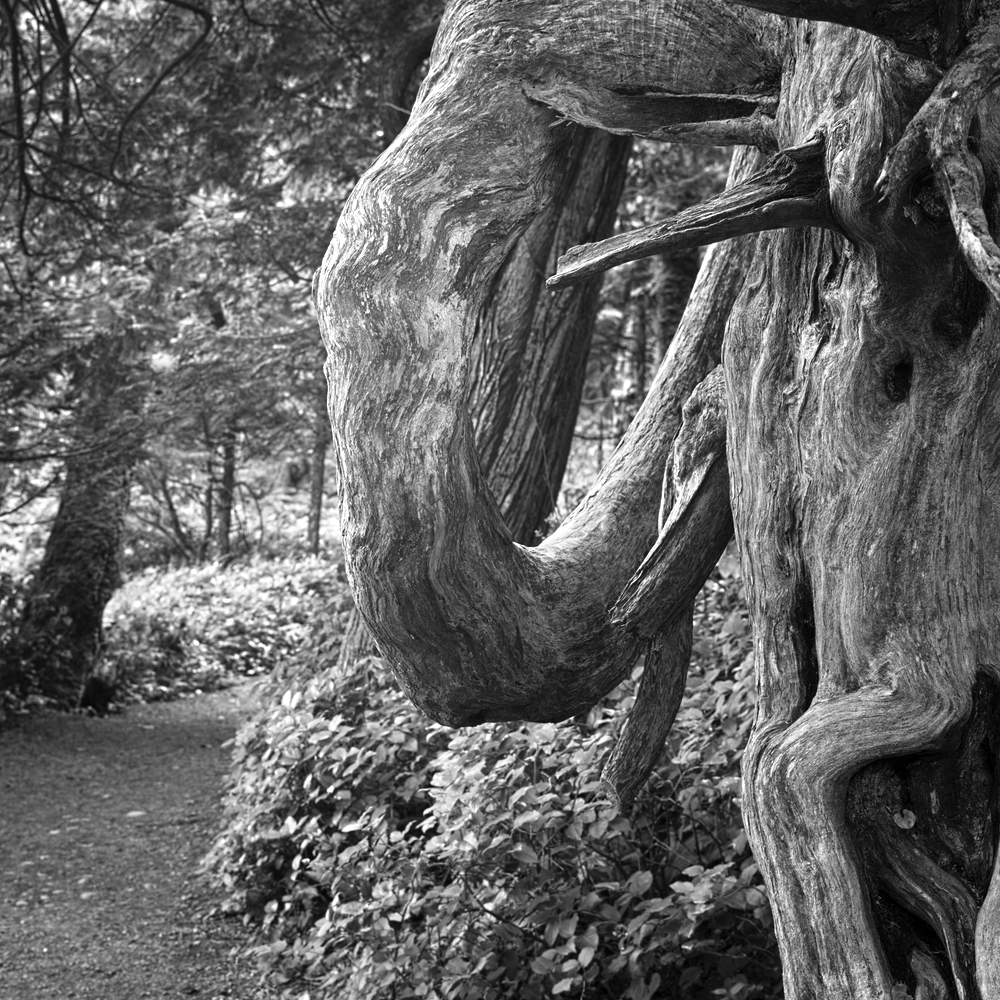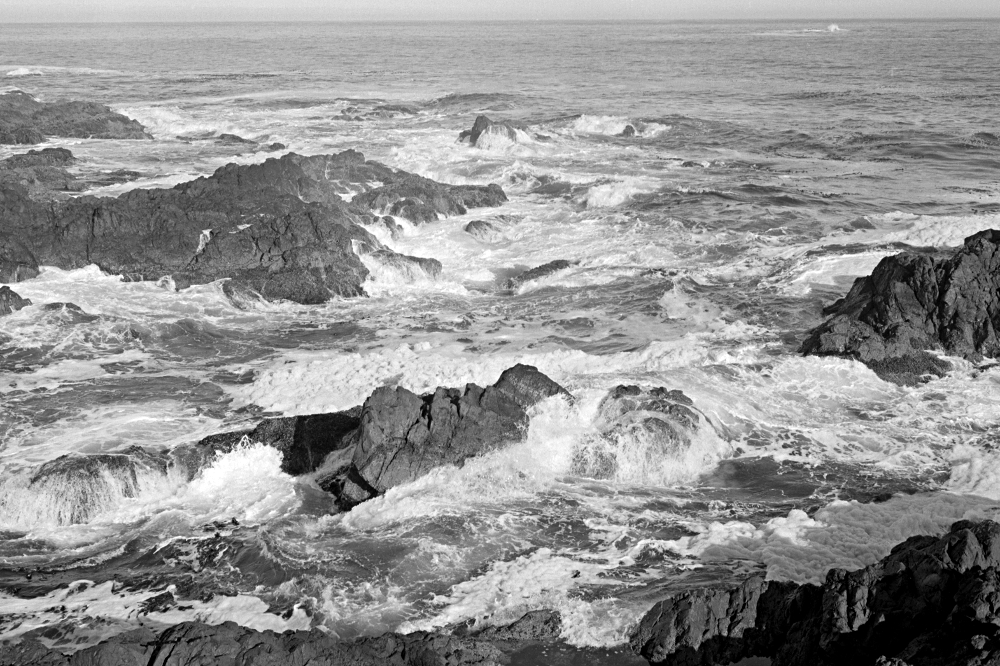The Salish Sojourn VIII
Ucluelet, British Columbia

The windtwisted trees of the Wild Pacific Trail
The Wild Pacific Trail is one of Ucluelet's premier attractions. Paralleling the storm-battered rocks of the coastline, this scenic trail is divided into two sections: a two kilometer loop around the southern tip of the peninsula, and a six kilometer hike between Big Beach and an ancient cedar grove to the north.
On a clear, sunny morning (a rarity in Ucluelet) we opt to hike the entire trail. Since the northern segment is longer, we elect to begin with that, tackling it while we are fresh and perky. We hike from the harbor, up over the spine of Peninsula Street, past the High School (rallying point should there be a tsunami) and then down to the southern terminus of the trail, Big Beach Park.
Warning signs caution hikers about the three varieties of wildlife they might encounter on the trail: bears, wolves, and cougars. I suspect that we are most likely to encounter bears, but, according to statistics, Vancouver Island has one of the highest cougar concentrations in the world. The nice thing about cougars is that they are quiet. A bear will come smashing through the woods, knocking down saplings like a runaway bowling ball, and making so much noise that you are as likely to die of cardiac arrest as by a mauling. Your final moments, as you make the transition from this world to the next, will be spent in a paroxysm of sheer panic.
Cougars, on the other hand, are far more circumspect. Like ghosts, they creep up behind you on silent paws and make a decision about your edibility. You will never know they are there, and should you appear unappetizing, they will slink back into the shadows without disturbing your peace of mind. You can't help but know that the bear is stalking you, but the cougar is very considerate. A lovely animal. I would much rather be eaten by a cougar than a bear.
Having been warned of the dangers, we set off boldly through the cougar-haunted woods.
The community of Ucluelet deserves approbation for this excellent trail. A wide graveled path, it hugs the coast, ascending and descending into coves and bays of sea-blasted rock. We poke our noses into a few tide pools, but the variety of sea life does not compare to what we found on San Juan Island. A few star fish, a handful of tattered green sea anemones, and the ever-present hermit crabs. My theory is that the intensity of the ocean waves makes life perilous and difficult for most species here. The protected waters of Haro Strait are probably more conducive to a wider variety of creatures.

Storm-pounded rocks
As we hike northward, we encounter a series of "Artists Loops" — byways that have been set up over scenic vistas for those who wish to capture a view with easel and brushes, or pen and poetry. I imagine other artists would not be discouraged — these are simply the alternatives that popped first into my mind. The serious through-hiker, grinding out the kilometers, can avoid the detours of the Artists Loops and press on with all speed. We, however, are artists, and end up making every extra loop.

Inspirational views from the trail will stimulate even the most jaded artist
Near the northern end of the trail we enter the Ancient Cedar grove. May I just take a moment to wax rhapsodical about the Western Red Cedar? What an incredible tree! Prized by the First Nations peoples (used to make everything from totem poles to canoes, ropes to medicine) the Cedar is a marvel second, perhaps, only to the Sequoia of Northern California. These trees can grow to a height of 230 feet tall and live for more than 1,000 years. Loaded with rot resistant oils, the snags can remain standing for another hundred years after their death.
The Wild Pacific Trail makes a loop through a grove of these trees. Spaced among the lesser Spruce and Hemlock, these giant denizens climb out of sight above us. It is amazing to place one's hand on a living being that was probably alive before the first Europeans reached these shores, and will probably still be living centuries from now when I have long passed out of the world's memory.
Our trail comes to an end just beyond the grove, leaving us a couple of miles to hike back into town. As we've been walking, I've kept a weather eye on a bank of fog sitting about five miles out to sea. Too many years living on the coast in Grays Harbor convince me that our sunny day is at risk. Sure enough, shortly after we return to our aerie, fog begins sliding up the channel, obscuring, first, the trees at the far end, and, next, the fishing boats in the middle distance. This is typical weather along the Pacific Coast — it becomes so bad in the later summer that the locals of Ucluelet have renamed the most notorious month "Fogust." When the sun heats the land, the rising air creates a local low pressure area, which pulls the fog in from the sea.

Fog rolls quickly in from the sea, obscuring the harbor
This time it proves to be a tease: the fog occludes the marina, obscuring it for a few minutes, then begins to roll back toward the sea. In ten minutes I can see all the way across the water to the battered houses of Port Albion again. A line of roiled cumulus clouds was been approaching from the south; I expect that they will also impact our weather and doubt whether tomorrow will be as fine.
In the evening we knock out the second section of the Wild Pacific Trail. Unfortunately, the two parts of the trail do not connect, so we drive south to the 2.6 kilometer loop around the southern end of peninsula.
It is a beautiful evening, with the sun declining in the golden western sky. There are more people out tonight, or, possibly, the shorter southern loop of the Wild Pacific Trail is simply more popular. In any event, we encounter more hikers than we saw in the morning.
The southern trail works around the back side of the peninsula, and ultimately arrives at Amphitrite Point, which marks the southern opening of the harbor. May I just say that the lighthouse at Amphitrite Point is possibly the ugliest lighthouse on the entire Pacific Coast? A square, white box of a building — a cross between a two-layered wedding cake and an hatbox — squats on the rocks.

Amphitrite Point Lighthouse, Ucluelet, BC
Its shape was dictated by the hostility of its environment. Although the sea is relatively calm when we visit, hurricane force winds often push waves right over the structure. The first attempt at a navigational aid was an open wood tower, built on the spot in 1906. This lasted eight years, before a wave swept the tower away. The present monstrosity, built of concrete and stone, was finished in 1915. It is a dangerous spot: a placard shows a three photo sequence of tourists standing out on the rocks beside the lighthouse (ignoring the danger signs): first, happy people waving at a camera, next a wall of white water rising behind them, and in the final image, they are engulfed. Their ultimate fate is a mystery: were they swept out to sea, or simply soaked? In any event, even on a calm day, rogue waves crossing the Pacific make the rocks around the lighthouse extremely perilous.
The harsh environment also has a profound effect on the trees. Wind-scoured and fell-blasted, the Spruce have been twisted into fantastic shapes by the relentless onslaught of sea and storm. Foliage is stripped from the windward side of the trunks, while on the leeward, long branches stream away like hair before a blow-dryer.

Wind-shaped trees on the Wild Pacific Trail, Ucluelet, BC
The trees form a tunnel of gnarled limbs, arching over the trail and offering ample cover for stalking cougars.

An eerie tunnel of trees on the Wild Pacific Trail, Ucluelet, BC
The circuit concludes in the parking lot where we began. We have put several miles on our pedometers today, and it has certainly been worth the effort. The Wild Pacific Trail is truly a marvel, a trail with gorgeous vistas, stunning forests, and a route that is not to be missed by visitors to this particular edge of the world.
If you are enjoying this series, why not subscribe to Richard's monthly newsletter, What's New in Old News? The Peripatetic Historian is on the road, roaming the world and compiling fresh adventures. Don't miss out. Click here to join the legions of above-average readers who have already subscribed.